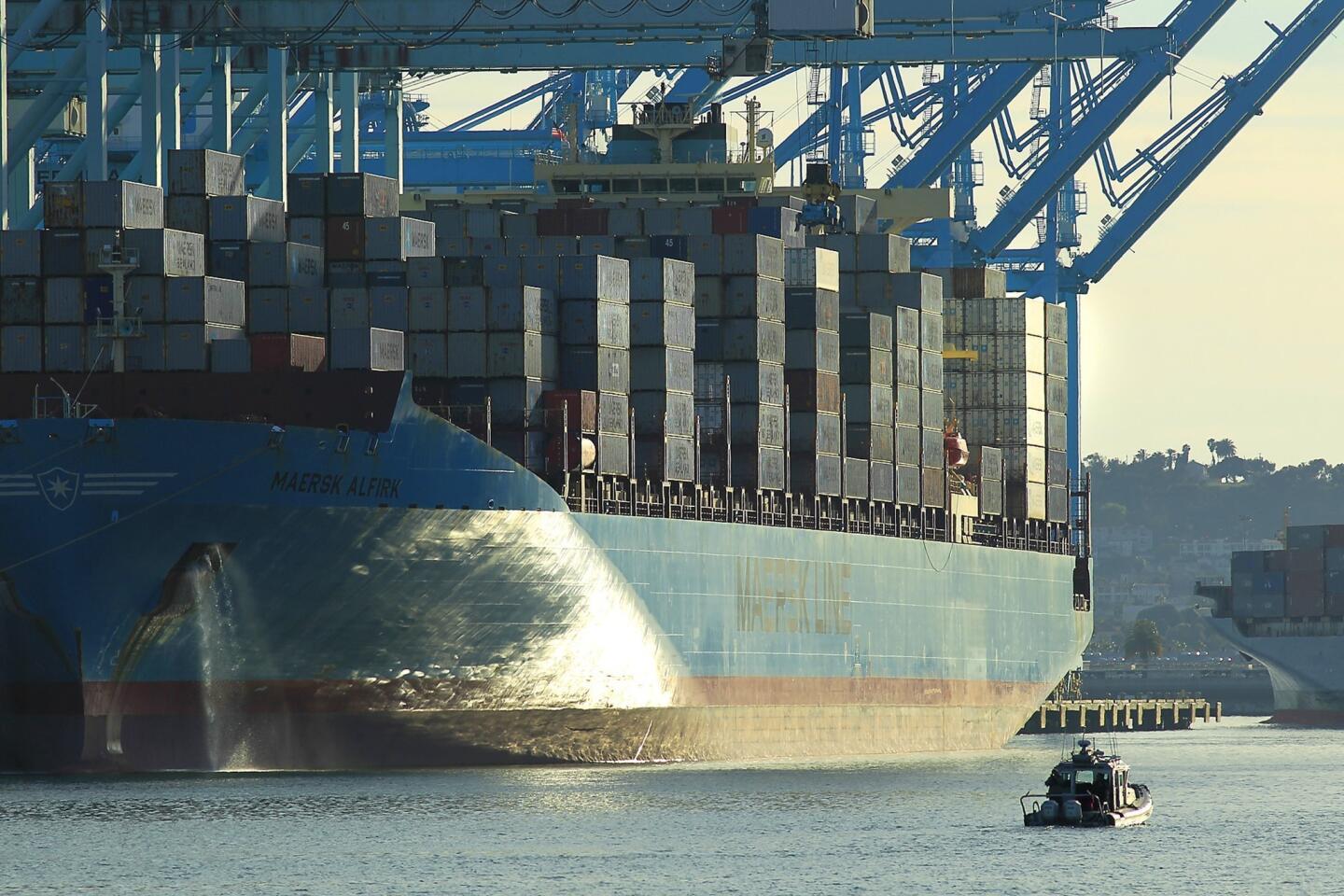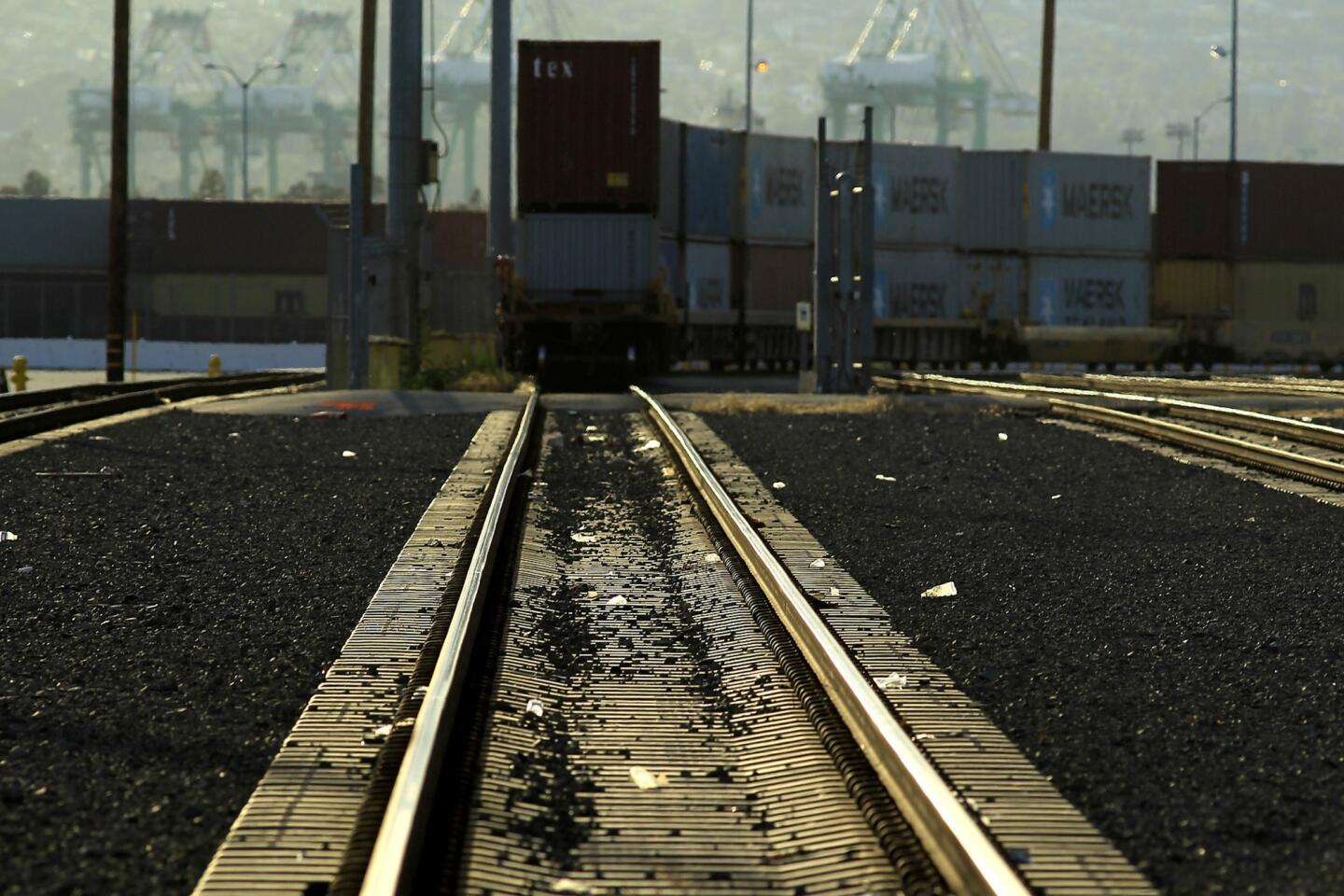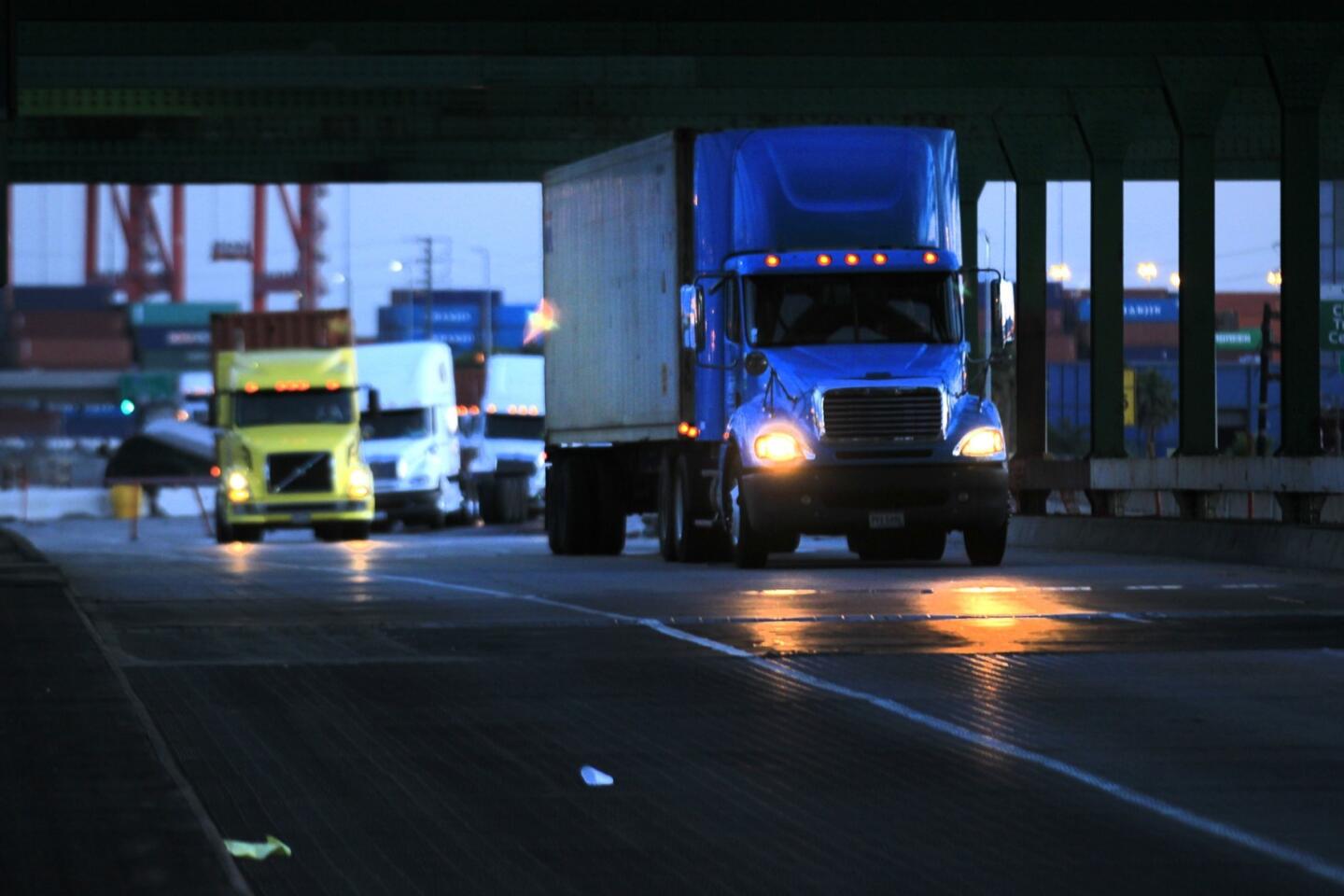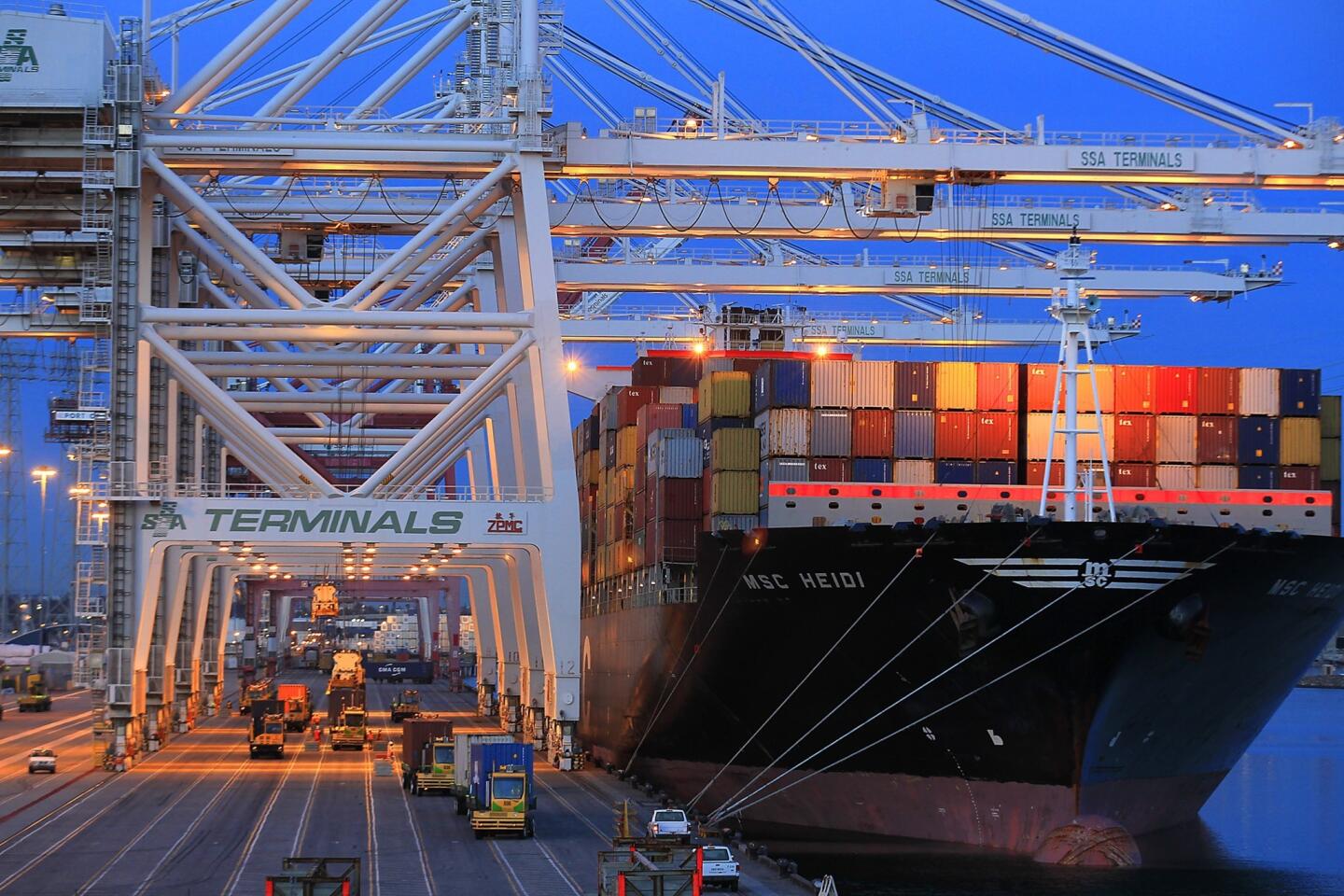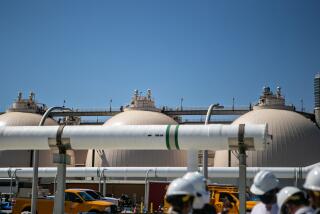Port of Los Angeles has failed to meet pollution-cutting measures
The Port of Los Angeles has failed to carry out vital pollution-reduction measures it agreed to make after a legal settlement more than a decade ago, according to a document released by the port.
In an environmental notice, the port revealed it has not completed 11 of 52 measures it agreed to impose to reduce air pollution, noise and traffic when it allowed the expansion of the China Shipping terminal.
Among the steps not taken are requirements that all ships slow as they approach the port and shut down their diesel engines and plug in to onshore electricity when docked to reduce harmful emissions. Also not met were mandates that trucks and yard tractors be fueled by less-polluting natural gas and other alternative fuels.
See the most-read stories this hour >>
China Shipping North America operates the 130-acre terminal near the Vincent Thomas Bridge under a lease agreement that expires in 2030. It is one of the busiest tenants at the publicly owned port, accounting for about 20% of the port’s container volume. The company did not respond to calls requesting comment to its office in Long Beach and its corporate headquarters in Montvale, N.J.
Port officials on Tuesday blamed the inaction on previous administrators and vowed to correct the situation.
The revelation stunned environmentalists and community groups, who say it raises questions about how much the port has truly cleaned up what has been hailed as the first “green” container terminal in the world.
“This whole time we’ve been led to believe that this is a much cleaner project than it has been,” said Mark Lopez, who heads East Yard Communities for Environmental Justice. He said the pollutants could bring “untold health consequences to the community.”
News of the failures comes more than a decade after community groups and residents filed a lawsuit against the terminal expansion. A legal settlement required the port to put $50 million in a fund to offset the effects of more trucks, ships and cargo-handling equipment on nearby communities such as San Pedro and Wilmington, and to conduct more environmental reviews. Those studies forced the port to include an array of new restrictions on the project before it was approved in 2008.
In written comments, port officials said they never revised their long-term lease agreement with China Shipping to include the required mitigation measures. Through a spokesman, port officials declined to be interviewed.
In the remarks prepared for a community meeting on the matter last week, Port of Los Angeles Executive Director Gene Seroka said that “we are faced with an unfortunate issue of delayed implementation” that was inherited from past port management. He vowed to fix the problem, saying, “We are committed to ensuring that something like this never happens again.”
Many of the air quality, noise and traffic-reduction measures agreed to in 2008 “had never been attempted anywhere in the world,” Seroka’s statement said. “The port believed, at the time, that these measures, although far-reaching, were realistic.”
This whole time we’ve been led to believe that this is a much cleaner project than it has been.
— Mark Lopez of East Yard Communities for Environmental Justice
But during a lengthy negotiation process with the company over the last several years, “it became apparent that there were technological, economic and operational challenges that suggest some of the adopted mitigation measures are infeasible.”
Environmental groups and the port have pointed to the changes required at the China Shipping terminal as a model for how to reduce air pollution and public health effects at seaports. Many of the pollution-cutting requirements debuted there became part of the Los Angeles and Long Beach ports’ Clean Air Action Plan that is credited with slashing diesel emissions over the last decade.
David Pettit, an attorney for the Natural Resources Defense Council, which in 2001 brought the lawsuit on behalf of residents and community groups that forced the port to adopt what at the time were cutting-edge clean air measures, said he “never thought for a second that they wouldn’t happen.”
“My belief is the port has known for years that the mitigation wasn’t happening and didn’t tell anybody,” Pettit said. “The issue now is what to do about it.”
Seroka learned of the situation after taking over as executive director in June 2014 and “is moving forward with a plan to remedy the issue,” Port of Los Angeles spokesman Phillip Sanfield said in an email. Asked how long the port has known about the shortcomings, Sanfield said that “the answer is not date-specific. Each mitigation measure has its own timeline.”
Port officials plan to conduct a new environmental review that will look at eliminating, replacing or revising the unmet requirements in ways that would achieve the same air quality, noise and traffic objectives.
The port’s disclosure followed public records requests from an alternative newspaper seeking documents on the mitigation measures.
The timing of the document released Sept. 18 was “suspiciously close” to the request, said James Preston Allen, publisher of Random Lengths News, which covers the Los Angeles-Long Beach harbor area and asked for the information under the Public Records Act.
Sanfield, the port spokesman, said “there is absolutely no relationship” between the records requests and the environmental document, which took months to draft.
The ports of Los Angeles and Long Beach are the busiest in the nation and generate more air pollution than any other facility in the Los Angeles Basin, attracting thousands of diesel-powered trucks, ships and trains. Cleaner trucks, fuels and other rules have in recent years slashed diesel emissions and cancer risk in nearby communities including West Long Beach, but air quality officials say both remain too high.
tony.barboza@latimes.com
Twitter: @tonybarboza
ALSO
Top L.A. County sheriff’s official steps down amid investigation into purchase of stolen car
UC Berkeley defends action against professor accused of sexual harassment
Passenger jet aborts takeoff when car makes wrong turn onto LAX runway
More to Read
Start your day right
Sign up for Essential California for news, features and recommendations from the L.A. Times and beyond in your inbox six days a week.
You may occasionally receive promotional content from the Los Angeles Times.
